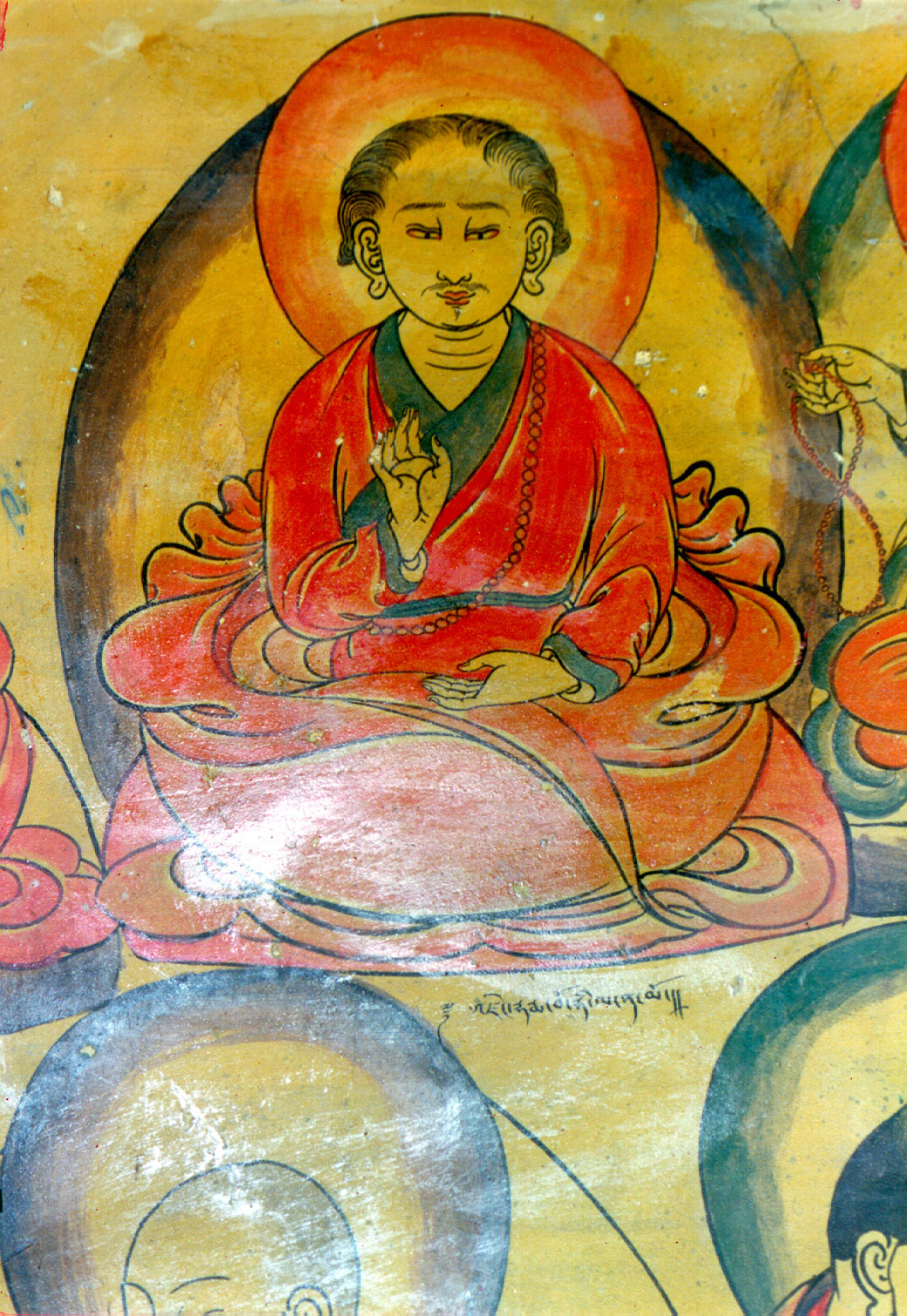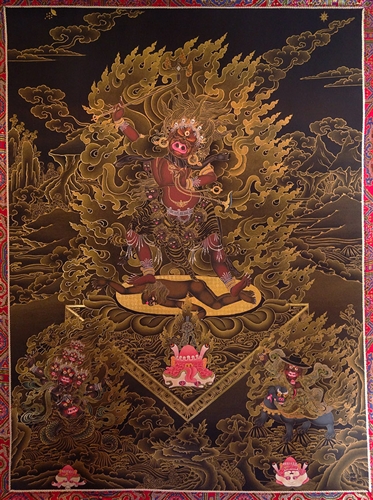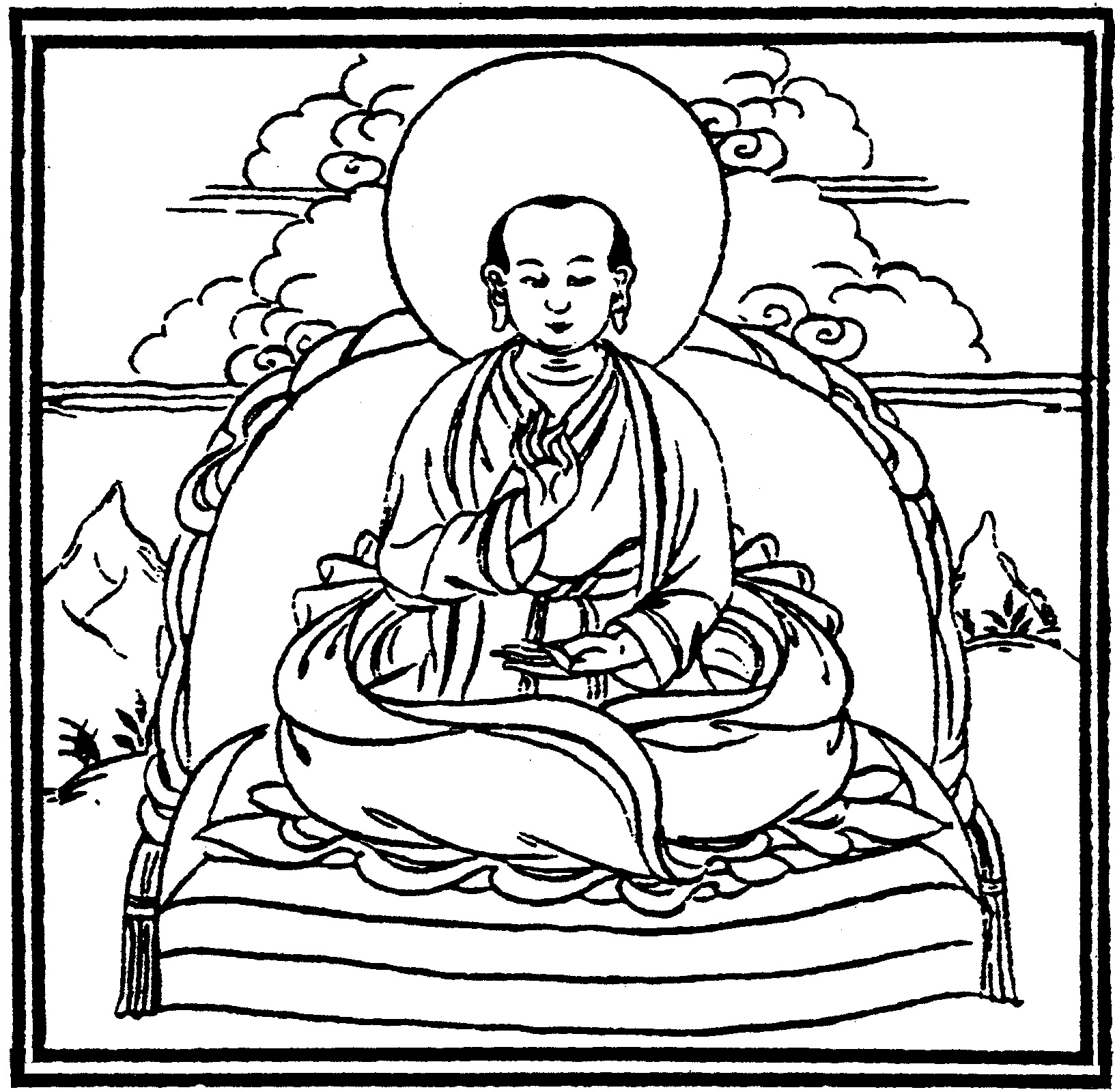|
Mengagde
In Tibetan Buddhism and Bon, Menngagde (, sa, upadeśavarga), is the name of one of three scriptural and lineage divisions within Dzogchen (''Great Perfection'' ). Dzogchen is itself the pinnacle of the ninefold division of practice according to the Nyingma school of Tibetan Buddhism. Menngagde focuses on rigpa. The Menngagde or 'Instruction Class' of Dzogchen teachings are divided into two parts: ''trekchö'' and ''tögel''. Practice For general purposes, Menngagde may also be known as Nyingthik. Germano & Gyatso (2000: p. 240) note a similarity of practice between Chan-like formless meditations and Nyingthik/Menngagde: In the Dzogchen textual tradition Traditionally, Mañjuśrīmitra () is said to have classified all the Dzogchen teachings transmitted by his teacher, Garab Dorje, into three series: semdé (), Longdé (), and menngagdé. Mañjuśrīmitra's student Sri Singha reedited the oral instruction cycle and in this form the teaching was transmitted to Jñān ... [...More Info...] [...Related Items...] OR: [Wikipedia] [Google] [Baidu] |
Longdé
Longdé (, sa, abhyantaravarga) is the name of one of three scriptural divisions within Dzogchen, which is itself the pinnacle of the ninefold division of practice according to the Nyingma school of Tibetan Buddhism Tibetan Buddhism (also referred to as Indo-Tibetan Buddhism, Lamaism, Lamaistic Buddhism, Himalayan Buddhism, and Northern Buddhism) is the form of Buddhism practiced in Tibet and Bhutan, where it is the dominant religion. It is also in majo .... The name "longdé" is translated as "Space Division" or "Space Series" of Dzogchen and emphasises the emptiness () or spaciousness () aspect of the Natural State. Due to the different approaches of various Dzogchen lineages, three series of teachings have developed, of which longdé is one. The other two divisions or series are semde and menngagde. Penor Rinpoche attributes longdé to Dorje Zampa, Sri Singha and Vairotsana's lineage. History The series of Space reflects the developments of the 11th–14th centu ... [...More Info...] [...Related Items...] OR: [Wikipedia] [Google] [Baidu] |
Yana (Buddhism)
Yāna (Sanskrit: यान and Pāli: "vehicle") refers to a mode or method of spiritual practice in Buddhism. It is claimed they were all taught by the Gautama Buddha in response to the various capacities of individuals. On an outwardly conventional level, the teachings and practices may appear contradictory, but ultimately they all have the same goal. Nomenclature, etymology and orthography In form, yāna is a neuter noun derived from the Sanskrit root yā- meaning to "go to" or "move" or "reach". The suffix employed to form this noun may have different values: while primarily yāna is understood to refer to the means (kara.na) through which one goes to/ reaches a location, it may technically also refer to the action itself (bhāva). Yāna is therefore primarily a "vehicle", in most contexts relevant to the Buddhist doctrine of three yānas. "Vehicle" is often used as a preferred translation as the word that provides the least in the way of presuppositions about the mode of t ... [...More Info...] [...Related Items...] OR: [Wikipedia] [Google] [Baidu] |
Tibetan Script
The Tibetan script is a segmental writing system (''abugida'') of Brahmic scripts, Indic origin used to write certain Tibetic languages, including Lhasa Tibetan, Tibetan, Dzongkha, Sikkimese language, Sikkimese, Ladakhi language, Ladakhi, Jirel language, Jirel and Balti language, Balti. It has also been used for some non-Tibetic languages in close cultural contact with Tibet, such as Thakali language, Thakali. The printed form is called uchen script while the hand-written cursive form used in everyday writing is called umê script. This writing system is used across the Himalayas, and Tibet. The script is closely linked to a broad ethnic Tibetan identity, spanning across areas in India, Nepal, Bhutan and Tibet. The Tibetan script is of Brahmic scripts, Brahmic origin from the Gupta script and is ancestral to scripts such as Meitei script, Meitei, Lepcha script, Lepcha,Daniels, Peter T. and William Bright. ''The World's Writing Systems''. New York: Oxford University Press, 1996. ... [...More Info...] [...Related Items...] OR: [Wikipedia] [Google] [Baidu] |
Semde
Semde (; Sanskrit: ) translated as 'mind division', 'mind class' or 'mind series' is the name of one of three scriptural and lineage divisions within Atiyoga, Dzogchen or the Great Perfection which is itself the pinnacle of the ninefold division of practice according to the Nyingma school of Tibetan Buddhism. Semde emphasizes the clarity (''gsal-ba'') or the innate awareness ( rig-pa) aspect of the Natural State. Due to the different approaches of various Dzogchen lineages, three series have developed of which ''semde'' is one. The other two divisions or series are Longdé (Space Series) and Menngagde (Instruction Series). The Mind Series is attributed to Sri Singha and Vairotsana's lineage Background The 'Three Series of Dzogchen' (''rdzogs chen sde gsum'') are a traditional Tibetan Buddhist classification which divides the teachings of the Nyingma school's Dzogchen tradition into three series, divisions or sections. These three are: the ''Semde'' ('Mind Series'), the '' ... [...More Info...] [...Related Items...] OR: [Wikipedia] [Google] [Baidu] |
Ekajati
Ekajaṭī or Ekajaṭā (Sanskrit: "One Plait Woman"; : one who has one knot of hair), also known as Māhacīnatārā,''The Alchemical Body: Siddha Traditions in Medieval India'' By David Gordon White. pg 65 is one of the 21 Taras. Ekajati is one of the most powerful and fierce protectors of Vajrayana Buddhist mythology. According to Tibetan legends, her right eye was pierced by the tantric master Padmasambhava so that she could much more effectively help him subjugate Tibetan demons. Ekajati is also known as "Blue Tārā", "Black Tārā", "Vajra Tārā" or "Ugra Tārā". She is generally considered one of the three principal protectors of the Nyingma school along with Rāhula and Vajrasādhu (). Often Ekajati appears as liberator in the mandala of the Green Tara. Along with that, her ascribed powers are removing the fear of enemies, spreading joy, and removing personal hindrances on the path to enlightenment. Ekajati is the protector of secret mantras and "as the mother o ... [...More Info...] [...Related Items...] OR: [Wikipedia] [Google] [Baidu] |
Seventeen Tantras
The ''Seventeen Tantras of the Esoteric Instruction Series'' () or the ''Seventeen tantras of the Ancients'' (''rnying-ma'i rgyud bcu-bdun'') are an important collection of tantras in the Nyingma school of Tibetan Buddhism. They comprise the core scriptures of the "esoteric instruction series" (''Menngagde'') of Dzogchen teachings and are its most authoritative scriptures. The Seventeen Tantras are part of the ''Vima Nyingthig'' (''"Inner Essence of Vimalamitra"''), a terma cycle of Dzogchen texts revealed by the treasure discoverer Zhangton Tashi Dorje (c. 1097-1127) and associated with the 8th century Indian monk Vimalamitra who is traditionally believed by the Nyingma school to have first brought these texts to Tibet. The ''Vima Nyingthig'' itself consists of 'tantras' (''rgyud''), 'agamas' (''lung''), and ' upadeshas' (''man ngag''). The other texts are mainly exegetical literature on the material found in the Seventeen tantras. The Seventeen Tantras explain the view ( ... [...More Info...] [...Related Items...] OR: [Wikipedia] [Google] [Baidu] |
Sādhanā
''Sādhanā'' (; ; ) is an ego-transcending spiritual practice. It includes a variety of disciplines in Hindu, Buddhist and Jain traditions that are followed in order to achieve various spiritual or ritual objectives. Sadhana is done for attaining detachment from worldly things, which can be a goal of a Sadhu. Karma yoga, Bhakti yoga and Gnyan yoga can also be described as Sadhana, in that constant efforts to achieve maximum level of perfection in all streams in day-to-day life can be described as Sadhana. ''Sādhanā'' can also refer to a tantric liturgy or liturgical manual, that is, the instructions to carry out a certain practice. Definitions The historian N. Bhattacharyya provides a working definition of the benefits of sādhanā as follows: B. K. S. Iyengar (1993: p. 22), in his English translation of and commentary to the ''Yoga Sutras of Patanjali'', defines sādhanā in relation to abhyāsa and kriyā: Paths The term sādhanā means "methodical dis ... [...More Info...] [...Related Items...] OR: [Wikipedia] [Google] [Baidu] |
Jamgon Kongtrul
Jamgön Kongtrül Lodrö Thayé (, 1813–1899), also known as Jamgön Kongtrül the Great, was a Tibetan Buddhist scholar, poet, artist, physician, tertön and polymath.Jackson, Roger R. The Tibetan Leonardo, 2012, https://www.lionsroar.com/the-tibetan-leonardo/ He was one of the most prominent Tibetan Buddhists of the 19th century and he is credited as one of the founders of the Rimé movement (non-sectarian), compiling what is known as the "Five Great Treasuries".Jamgon Kongtrul, Kalu Rinpoche translation group, The Treasury of Knowledge: Book One: Myriad Worlds, Translators' Introduction. He achieved great renown as a scholar and writer, especially among the Nyingma and Kagyu lineages and composed over 90 volumes of Buddhist writing, including his magnum opus, '' The Treasury of Knowledge''. Overview Kongtrül was born in Rongyab (rong rgyab), Kham, then part of the Derge Kingdom.Alexander Gardner, "Jamgon Kongtrul Lodro Taye," Treasury of Lives, accessed May 18, 2018, ht ... [...More Info...] [...Related Items...] OR: [Wikipedia] [Google] [Baidu] |
Tibet
Tibet (; ''Böd''; ) is a region in East Asia, covering much of the Tibetan Plateau and spanning about . It is the traditional homeland of the Tibetan people. Also resident on the plateau are some other ethnic groups such as Monpa people, Monpa, Tamang people, Tamang, Qiang people, Qiang, Sherpa people, Sherpa and Lhoba peoples and now also considerable numbers of Han Chinese and Hui people, Hui settlers. Since Annexation of Tibet by the People's Republic of China, 1951, the entire plateau has been under the administration of the People's Republic of China, a major portion in the Tibet Autonomous Region, and other portions in the Qinghai and Sichuan provinces. Tibet is the highest region on Earth, with an average elevation of . Located in the Himalayas, the highest elevation in Tibet is Mount Everest, Earth's highest mountain, rising 8,848.86 m (29,032 ft) above sea level. The Tibetan Empire emerged in the 7th century. At its height in the 9th century, the Tibet ... [...More Info...] [...Related Items...] OR: [Wikipedia] [Google] [Baidu] |
Vimalamitra
Vimalamitra () was an 8th-century Indian Buddhist monk. His teachers were Buddhaguhya, Jñānasūtra and Śrī Siṃha. He was supposed to have vowed to take rebirth every hundred years, with the most notable figures being Rigzin Jigme Lingpa, Khenchen Ngagchung, Kyabje Drubwang Penor Rinpoche and Kyabje Yangthang Rinpoche. He was one of the eight teachers of the great Indian adept Guru Padmasambhava. Centuries later, terma and various works were attributed to him. Chatral Sangye Dorji (1913-2016) was said to have received a mala rosary from a man who was at the time dressed as an Indian Sadhu. It was only later that Rinpoche told his attendants that he received a mala on that day from Vimalamitra in reality. The attendants were curious and returned to the place where they had met a sadhu only to be left dumbstruck. The sadhu was not to be found anywhere. One scholar remarked that the historical Vimalamitra "would have been astonished to find himself the focus of such a tradit ... [...More Info...] [...Related Items...] OR: [Wikipedia] [Google] [Baidu] |
Sri Singha
Sri Singha (Sanskrit: , ) was the teacher of Padmasambhava, Vimalamitra, and Vairotsana. He was a principal student and dharma-son of Mañjuśrīmitra in the Dzogchen lineage, and is credited by the Nyingma school with introducing Dzogchen to Tibet. Life Sri Singha is the son of King 'Accomplisher' and his wife queen Nantakā. A.W. Barber notes that Sri Simha took the Atiyoga lineage to Andhra, in South India. He made his residence at Dhanyakataka. Thus, it would appear that Sri Simha took the Atiyoga line to Andhra and made his residence at the famous Dhanyakataka along the Krishna River. From here it was transmitted to teachers who then took the line to Tibet and China. Achievements Śrī Siṃha brought the Secret Mantra teachings from beneath the Vajra Throne in Bodhgaya to the 'Tree of Enlightenment' in China, where he concealed them in a pillar of the 'Auspicious Ten Thousand Gates Temple'. Śrī Siṃha conferred the Eighteen Dzogchen Tantras (Tibetan: ''rdzogs chen rg ... [...More Info...] [...Related Items...] OR: [Wikipedia] [Google] [Baidu] |
Semde
Semde (; Sanskrit: ) translated as 'mind division', 'mind class' or 'mind series' is the name of one of three scriptural and lineage divisions within Atiyoga, Dzogchen or the Great Perfection which is itself the pinnacle of the ninefold division of practice according to the Nyingma school of Tibetan Buddhism. Semde emphasizes the clarity (''gsal-ba'') or the innate awareness ( rig-pa) aspect of the Natural State. Due to the different approaches of various Dzogchen lineages, three series have developed of which ''semde'' is one. The other two divisions or series are Longdé (Space Series) and Menngagde (Instruction Series). The Mind Series is attributed to Sri Singha and Vairotsana's lineage Background The 'Three Series of Dzogchen' (''rdzogs chen sde gsum'') are a traditional Tibetan Buddhist classification which divides the teachings of the Nyingma school's Dzogchen tradition into three series, divisions or sections. These three are: the ''Semde'' ('Mind Series'), the '' ... [...More Info...] [...Related Items...] OR: [Wikipedia] [Google] [Baidu] |





